The ASUS ZenFone 2 Review
by Brandon Chester on May 26, 2015 8:00 AM ESTDisplay
In recent times we've seen a tremendous improvement in smartphone and tablet display quality. It began with high end flagship phones, and eventually trickled down to more budget oriented smartphones. Even a $130 smartphone like the 2015 Moto E can have a decent IPS display. However, I'm hesitant to describe the Zenfone 2 as a "budget" smartphone. While I don't mean for the word to have negative implications, it's often interpreted as meaning low quality or cheap. The Zenfone 2 is better described as an inexpensive smartphone. Much like the OnePlus One did when it was released, the Zenfone 2 offers some very serious hardware at a price much lower than what has become the going rate for flagship smartphones.
The display in the Zenfone 2 is a 5.5" 1920x1080 IPS LCD panel. This is another specification that you would expect to see in a $650 flagship device that is instead inside one that starts at $199. While phones are now moving to 2560x1440, on RGB stripe panels I don't feel that there are significant benefits to moving past 1080p even on 5.5" displays. On top of that, a display's resolution is just one of many attributes that contributes to its quality. Color accuracy, brightness, and contrast are all important aspects of a display. To accurately characterize these areas of display performance, we use SpectraCal's CalMAN 5 software and X-Rite's i1Pro 2 spectrophotometer.
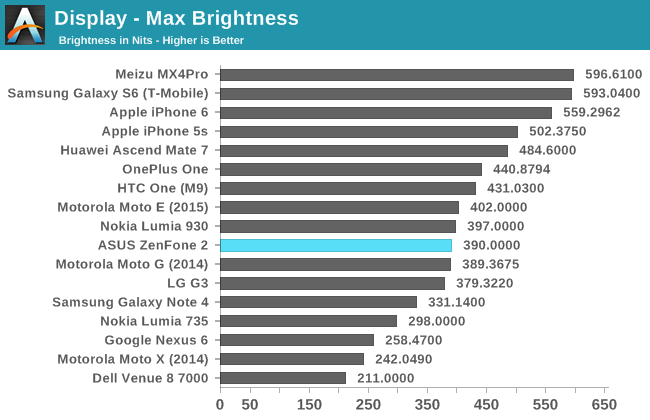
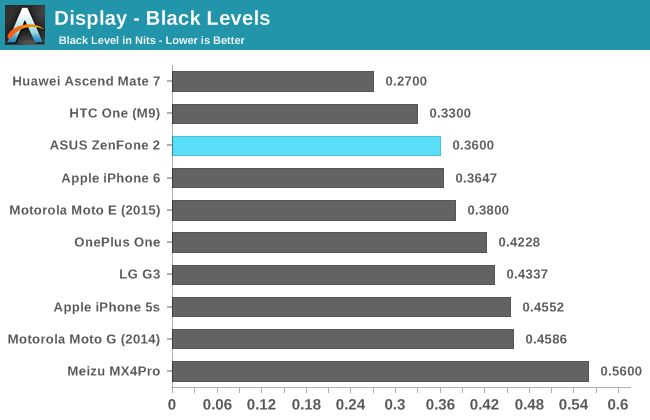
The Zenfone 2 appears to be off to a good start. Black levels are very low among our LCDs, and the max brightness is somewhat low but not terrible by any means. I never had any issues when using the Zenfone 2 outside, although it was definitely not as comfortable as the Galaxy S6.
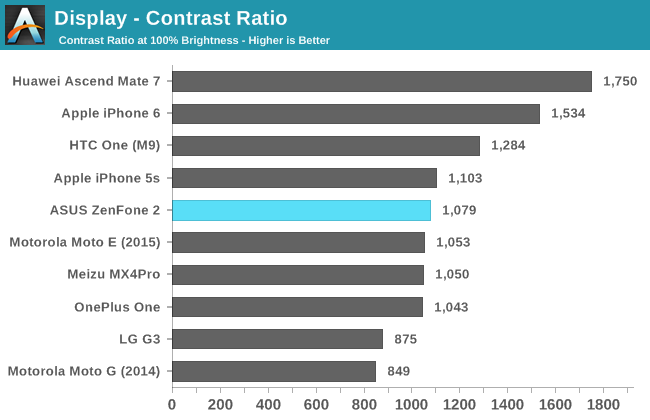
The slightly low max brightness and above average black level results put the Zenfone 2 right in the middle of our LCD devices when it comes to contrast ratio.
Unfortunately, these numbers are somewhat misleading. This is because the Zenfone 2 makes extremely heavy use of dynamic contrast and contect adaptive backlighting (CABC). I have never used another device with such dramatic shifts in backlight power. The best example I've found is when switching from an all black to all white screen at max brightness. While this is obviously an extreme case, it illustrates the behavior that is occuring very well. At the moment you switch to white, the brightness of the display is around 170 nits. Over the next few seconds, that brightness rapidly increases to the 390 nits you see in the results above. This is an enormous jump in brightness, and it's very easy to see with your own eyes.
One last thing I'd like to note about the brightness is that the 100% setting on the built in brightness slider is not actually the max brightness that the display is capable of. The max you can achieve using the slider in the Settings app is 319 nits, which is around 82% of the 390 nit result you can get using applications like Brightness Adjuster from Google Play.
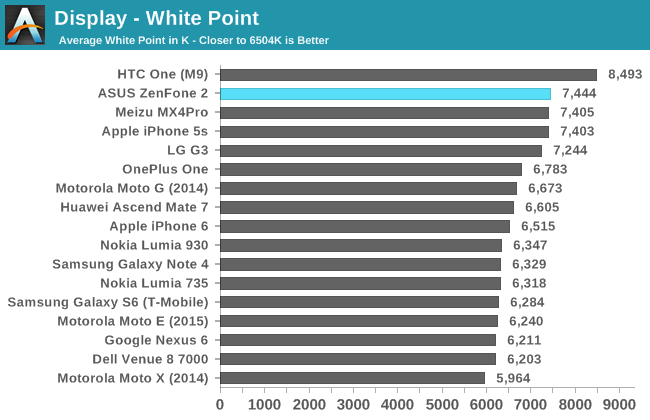
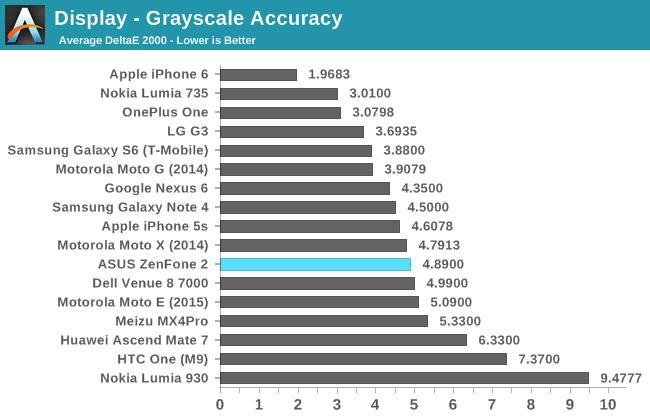
Greyscale accuracy on the Zenfone 2 is very average. The display is too blue, and this can be seen in the reproduction of shades of grey as their brightness goes beyond 15%. The gamma is also extremely irregular, and continually curves upward. This is the result of ASUS's heavy dynamic contrast and CABC. The brightness reductions with darker shades makes the display slower to move out of the shadows, which you can see in the color comparator chart above. Again I must reiterate that the color comparator is a relative color difference, as the bottom half which displays the "target" colors will be impacted by any inaccuracies in the display you use to view it.
Unfortunately, there's not much that can be done to improve greyscale accuracy when CABC is used heavily. Testing with constant APL patterns to try and avoid the brightness shifting did bring the gamma down to 2.4, but because the display still has a blue shift and the gamma is still too high, the average greyscale deltaE was around 4.5 which is still fairly high.
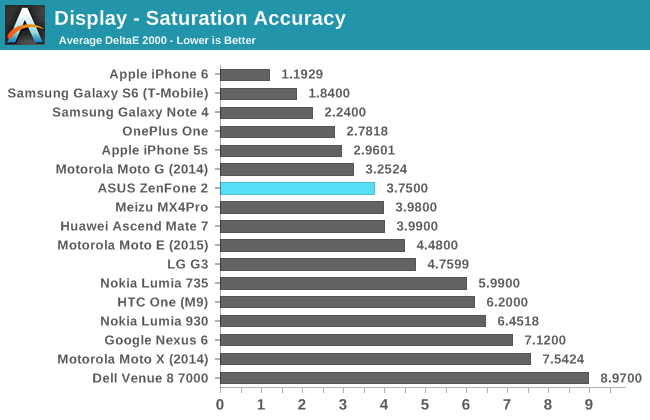
Saturation accuracy ends up being noticeably better than greyscale accuracy on the Zenfone 2. Blue and green manage to stay below the dE target of 3 for all saturation levels, while all the other colors hover somewhere between 4 and 6 on average. An average deltaE across all colors of 3.754 is not terrible by any means, and I don't think Zenfone 2 buyers will have any complaints about the accuracy of primary and secondary colors.
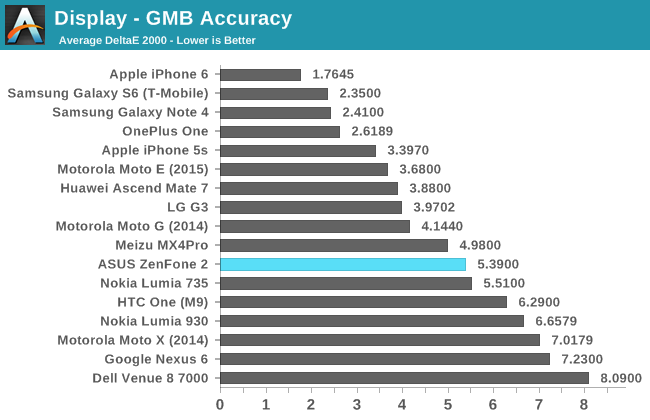
Unfortunately, the inaccurate greyscale and gamma of the Zenfone 2 comes back to haunt it in the Gretag MacBeth ColorChecker test. This test measures the accuracy of various color mixtures that are common in the real world, and the Zenfone 2 misses many of them by a significant degree. What's even more unfortunate is that the highest errors are in mixtures of yellow in red, with the largest error of all the colors tested being light skin tones. If there's one color I want a display to get right, it's skin tones.
The overall display performance of the ZenFone 2 is mixed at best. I'm glad it basically has the full sRGB gamut, and is fairly accurate with saturations of primary colors. However, it doesn't do very well when it comes to shades of grey, and it also has slightly lower accuracy with color mixtures than I had hoped. Devices like the 2015 Moto E show that it's possible to get close to that dE error target of 3 even on an inexpensive smartphone. I would still say that the ZenFone 2 has the best display at this price point purely on the merit of its pixel density, but I really wish that the calibration was better than it is.


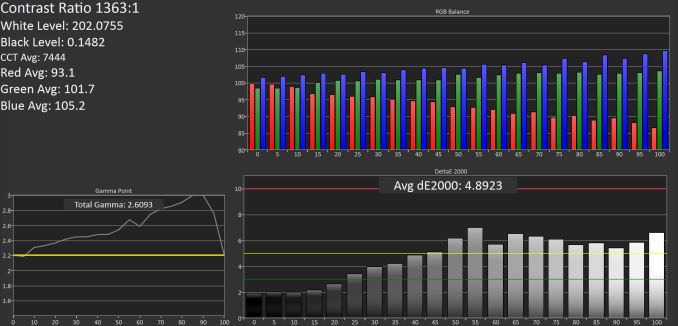

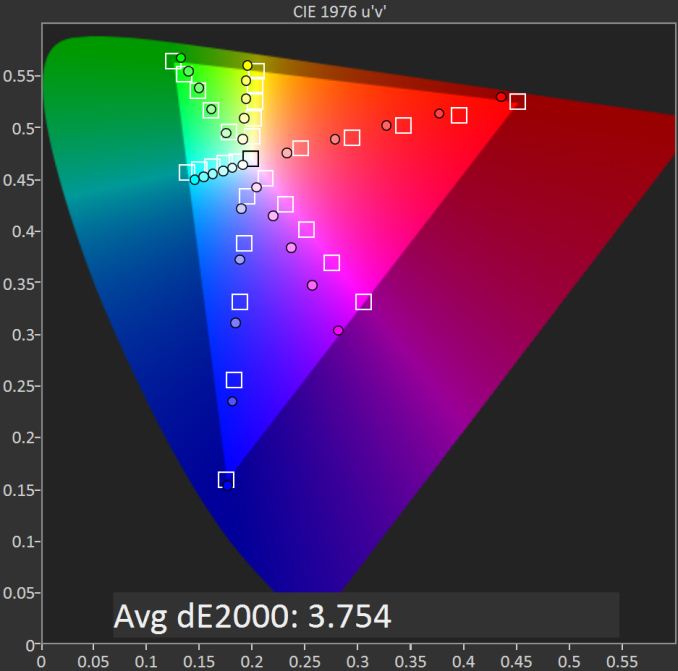









147 Comments
View All Comments
Brandon Chester - Tuesday, May 26, 2015 - link
Google Chrome is used for all of our browser tests, including battery life.re2onance - Tuesday, May 26, 2015 - link
I remember watching a review earlier about the screen being low in brightness. I thought it may have been on purpose although I assumed it was due to Asus trying to make up for the Intel SoC power consumption.I've read in the XDA forums that people experience better battery life after rooting and removing a lot of the bloatware apps, particularly the Asus built-in web browser that seems to be attached to the Trend Micro security. Honestly, people shouldn't have to root their device in order to eek out better battery life.
It seems kinda weird how Asus would spend the effort to gimp the screen from what it is actually capable of, and then fill it with apps which probably also could hinder battery life as well.
It seems like a good value phone, but the direction is all over the place.
I think the review seems fair since this is both the hardware and software Asus shipped with and updated.
T1beriu - Tuesday, May 26, 2015 - link
Brandon, could you actually disable all ASUS bloatware?I got an ASUS MeMO Pad 7 (ME572C) updated to 5.0 that looks exactly as your screenshots and I can't disable any of the useless ASUS apps.
Shame on you ASUS.
Brandon Chester - Tuesday, May 26, 2015 - link
No you can't disable all of it. I probably should have been more specific about that. You can uninstall or disable some apps such as the Apps4U apps and a few others like Omlet chat. Most of the apps that are actually from ASUS are stuck there though.ketacdx - Tuesday, May 26, 2015 - link
Hey Brandon. I thought the same but if you follow the method of holding the app in the app menu and drag it to uninstall at the top, that seems to work for most. For some reason I wasn't able to uninstall in Google Play for the same ones oddly, only disable.Brandon Chester - Wednesday, May 27, 2015 - link
That isn't working for me for apps like ZenCircle, Mirror, etc. The button to disable is greyed out.ketacdx - Thursday, May 28, 2015 - link
Yeah, I cant get those off either but it worked a lot of them thankfully. I really wish they enabled uninstall for the rest...tipoo - Tuesday, May 26, 2015 - link
"In the case of the ZenFone 2, we see that it lasts exactly as long as the HTC One (M9). Last run GPU performance is noticeably slower though."But isn't that just the relative performance difference between the two GPUs? I guess I still don't really understand the last run GPU framerate metric, shouldn't it be as a proportion of the first run framerate to mean anything? If one device performs at 100, another performs at 50, and the final runs of both are 50, the final run FPS would appear the same, but the second device didn't throttle at all while the first throttled by half.
Does the test already take this into account?
SHartman1976 - Tuesday, May 26, 2015 - link
I think you guys need to rerun the Nexus 6 battery benchmarks with 5.1 - the experience of myself and many others regarding N6 battery life is nothing like what you found on the initial 5.0 review.Brandon Chester - Wednesday, May 27, 2015 - link
I just finished re-testing the Nexus 6 on 5.1 and it lasted for 7 hours and 24 minutes in our browser test which is a worse result than the initial review. It's a small enough difference that I'll attribute it to battery degradation and/or test variance, but the point is that it hasn't improved at all.